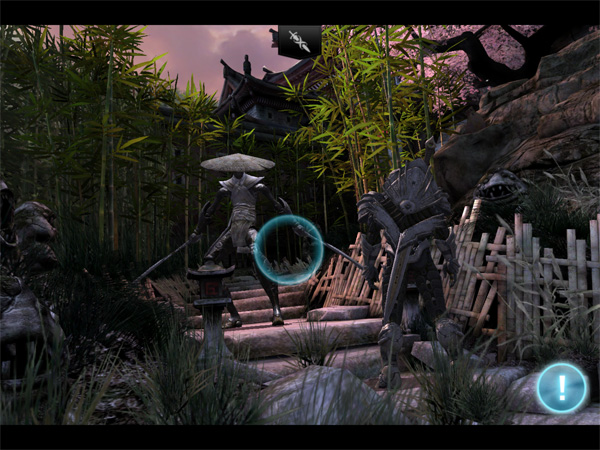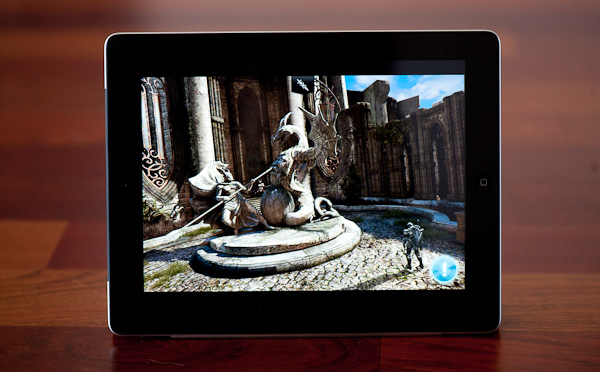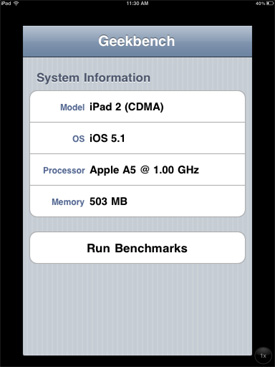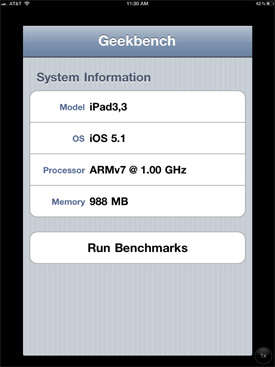The Apple iPad Review (2012)
by Vivek Gowri & Anand Lal Shimpi on March 28, 2012 3:14 PM ESTThe Display
The most visible improvement of the new iPad is naturally its Retina Display. Originally introduced with the iPhone 4, the concept of an Apple Retina Display was created to refer to a display where the pixel density was high enough that the human eye, at a standard viewing distance, could not resolve or identify individual pixels.
Unlike traditional OSes, iOS doesn't support a laundry list of display resolutions. The iPhone was introduced at 480 x 320 (3:2 aspect ratio), while the iPad came to be at 1024 x 768 (4:3 aspect ratio). Rather than require iPhone applications be redesigned for a higher resolution iPhone, Apple simply doubled both the vertical and horizontal resolution for the iPhone 4—maintaining the same aspect ratio as the previous models, and only requiring higher quality assets, not a redesigned UI, to take advantage of the new display.
The iPad on the other hand always required a redesigned UI to make the most of the iPad's larger display and higher resolution. With a different aspect ratio, simply scaling up an iPhone app wouldn't work (although to enable backwards compatibility Apple did allow you to do just that). Admittedly Apple wouldn't want to allow such easy portability between iPhone and iPad apps as it wanted the extra effort to improve the quality of tablet apps.
The new iPad does what the iPhone 4 did and doubles both horizontal and vertical resolution: from 1024 x 768 to 2048 x 1536. All iPad applications work by default as developers don't directly address pixels but rather coordinates on the screen. Existing apps take up the full screen, and if higher resolution images are present they are used as they avoid the interpolation associated with scaling up an image designed for the original iPad resolution. For example, below we have a makeshift iOS icon in three different forms—10x7 native (72x72), upscaled to a 2x version using bicubic interpolation (144x144), and a 2x resolution version (144x144):
|
72x72
|
144x144 (Upscaled)
|
144x144 (Native)
|
|
|
|
|
The upscaled form looks good, but the 2x resolution version looks better.
More traditional OSes have always given you additional desktop real estate with increased resolutions. iOS simply gives you a better looking desktop. This distinction is arguably one of the reasons why the new iPad's display can be so polarizing. As consumers of high-end displays we're used to higher resolution going hand in hand with a larger panel size. Alternatively, we're used to a higher resolution enabling us to see more on a screen at one time. In the case of the new iPad, the higher resolution just makes things look sharper. It's a ton of work for an admittedly more understated impact, but it's the type of thing that simply had to be done.
Retina Display Enabled Apps
Apple has created such a healthy marketplace with the app store that developers are eager to quickly deliver apps with updated graphics for the new iPad. Sure enough, by the day of launch we saw several high profile applications with higher resolution assets for the new iPad. The motivation to have Retina Display support is huge as Apple is actively promoting those apps that have been updated for the new iPad via the app store:

These updated apps now come with larger image assets, which can increase the total app size. Not all apps will grow in size (e.g. Infinity Blade 2 simply renders at a higher resolution vs. using tons of new content, not to mention that textures are already heavily compressed) but some have/will. The retina burden unfortunately impacts all iPads as there's only a single app package delivered upon download. Even if you don't use them, the higher resolution retina graphics are there.
Note that iPhone apps will now load their Retina assets (designed for 640 x 960) rather than their normal assets (designed for 320 x 480) on the new iPad, resulting in a significant improvement in image quality there as well:
Games are a special exception to the 2x asset scaling of the new iPad. Applications that simply have their UI accelerated by the A5X's GPU do fairly well at the iPad's native resolution. 3D games are another story however.
If all you're doing is determining the color of a single pixel on the screen, not impacted by lights in 3D space or other transparent surfaces above the surface, it's a relatively simple and painless process. For the majority of what you're looking at in iOS, this is simply the procedure. The app instructs the drawing APIs to place a red pixel at a set of coordinates and that's what happens. In a 3D game however, arriving at the color value of that pixel can require quite a bit of math, and quite a bit of memory bandwidth.
Game developers have a few options on the new iPad. One option is to not update a game, running it at 1024 x 768 and rely on the iPad's scaler to upscale the image to 2048 x 1536. The game will take up the full screen, run faster than on the iPad 2, but it won't necessarily look any better. Low resolution content upscaled to a higher resolution display still maintains much of the aliasing you'd see at a lower resolution.
Another option is to render all scenes at the new iPad's resolution: 2048 x 1536. With four times the number of pixels to fill and only 2x the compute and memory bandwidth compared to the iPad 2, this will only work for fairly lightweight content. Not to say that it's impossible—even GLBenchmark's Egypt test, in its current form, actually runs very well at the new iPad's native resolution. Many stressful 3D games won't fall into this category however.
The third, and more popular option is for a game developer to render all frames offscreen at an intermediate resolution between 1024 x 768 and 2048 x 1536, then scale up to the panel's native res. So long as the developer maintains aspect ratio, it'll be possible to use this approach and get a good balance of higher resolution and performance.

Infinity Blade 2 for the new iPad Renders at roughly 1.4x the iPad 2's resolution, then upscales to fill the screen
Infinity Blade 2, for example, renders offscreen at roughly 1.4x the resolution of the iPad 2 before scaling up to 2048 x 1536 for final display. The result is a sharper image than what you'd get on an iPad 2, without sacrificing performance.
Game developers may choose to increase the level of anti-aliasing instead of or in combination with an increase in resolution. As we'll discuss shortly, Apple's A5X does come equipped with more GPU execution resources and dedicated memory bandwidth for graphics that would allow for an increase in quality without a corresponding decrease in frame rate.



















234 Comments
View All Comments
Ammaross - Wednesday, March 28, 2012 - link
"It has the fastest and best of nearly every component inside and out."Except the CPU is the same as in the iPad2, and by far not the "best" by any stretch of the imagination. Hey, what's the problem though? I have this nice shiny new tower, loads of RAM, bluray, SSD, and terabytes of hard drive space. Oh, don't mind that Pentium D processor, it's "good enough," or you must be using it wrong.
tipoo - Wednesday, March 28, 2012 - link
What's better that's shipping today? Higher clocked A9s, or quad core ones like the T3? Either would mean less battery life, worse thermal issues, or higher costs. Krait isn't in a shipping product yet. Tegra 3's additional cores still have dubious benefit. These operating systems don't have true multitasking, you basically have one thing running at a time plus some background services like music, and even on desktops after YEARS few applications scale well past four cores outside of the professional space. The next iPad will be out before quad core on tablets becomes useful, that I assure you of.zorxd - Wednesday, March 28, 2012 - link
I'd gladly trade GPU power for CPU power.That GPU is power hungry too, probably more than two extra A9 cores, and the benefit is even more dubious unless you are a hardcore tablet gamer.
TheJian - Wednesday, March 28, 2012 - link
LOL, the problem is you'll have to buy that new ipad to take advantage because YOURS doesn't have those cores now. Once apps become available that utilize these cores (trust me their coming, anyone making an app today knows they'll have at least quad cpu and gpu in their phones their programming for next year, heck end of this year), the tegra 3 won't need to be thrown away to multitask. Google just has to put out the next rev of android and these tegra3's etc should become even better (I say etc because everyone else has quad coming at 28nm).The writing is on the wall for single/dual. The quad race on phones/tables is moving FAR faster than it did on PC's. After win8 these things will start playing a lot more nicely with our current desktops. Imagine an Intel x86 based quad (hopefully) with someone else's graphics running the same stuff as your desktop without making you cringe over the performance hit.
I'm not quite sure how you get to Tegra3 costing more, having higher thermals (umm, ipad 3 is hot, not tegra3). The die is less than 1/2 the size of A5x. Seems they could easily slap double the gpus and come out about even with QUAD cpu too. IF NV double the gpus what would the die size be? 162mm or smaller I'd say. They should have went 1920x1200 which would have made it faster than ipad 2 no matter what game etc you ran. Unfortunately the retina screen makes it slower (which is why apple isn't pushing TEGRA ZONE quality graphics in their games for the most part...Just blade?). They could have made this comparison a no brainer if they would have went 1920x1200. I'm still waiting to see how long these last running HOT for a lot of people. I'm not a fan of roasted nuts :) Too bad they didn't put it off for 3 months and die shrink it to at least 32nm or even 40nm would have helped the heat issue, upclock the cpu a bit to make up for 2 core etc. More options to even things out. Translation everything at xmas or later will be better...Just wait if you can no matter what you want. I'm salivating over a galaxy S2 but it's just not quite powerful enough until the shrinks for s3 etc.
tipoo - Wednesday, March 28, 2012 - link
I didn't say the Tegra 3 is more expensive or has higher thermals; I said the A5X, with higher clocked cores or more cores would be, and we all know Apple likes comfortable margins. Would I like a quad core A5X? Sure. Would I pay more for it? Nope. Would I switch for reduced battery life and an even hotter chip than what Apple already made? Nope. With the retina display, the choice to put more focus on the GPU made sense, with Android tablets resolution maybe Tegra 3 makes more sense, so you can stop attacking straw man arguments I never made. There are still only a handful of apps that won't run on the first iPad and that's two years old, "only" two cores won't hold you back for a while, plus iOS devs have less variation of specs to deal with so I'm sure compatibility with this iPad will be assured for at least two or three years. If I was buying one today, which I am not, I wouldn't be worried about that.Heck, even the 3GS runs most apps still and gets iOS updates.
pickica - Monday, April 2, 2012 - link
The New Ipad 2 is probably gonna have a dual A15, which means dual cores will stay.Peter_St - Monday, April 2, 2012 - link
The problem here is that most people have no idea what they are talking about. It was just few years ago that we all used Dual Core CPUs on our Desktop Computers and we ran way more CPU load intensive applications, and now all of a sudden some marketing bonzo from HTC and Samsung is telling me that I need Quasd Core CPU for Tablets and mobile devices, and 2+ GB of RAM,If you really need that hardware to run your mobile OS, then I would recommend you to fire all your OS developers, get a new crew, and start from scratch...
BSMonitor - Wednesday, March 28, 2012 - link
If you were to run the same applications a tablet is designed to, then yes, your Pentium D would actually be overkill.PeteH - Wednesday, March 28, 2012 - link
The point is made in the article is that it would be impossible provide the quad GPUs (necessary to handle that display) AND quad CPUs. Given you can only do one or the other, quad GPUs is the right choice.zorxd - Wednesday, March 28, 2012 - link
was it also the right choice to NOT upgrade the GPU when going from the iPhone 3GS to iPhone 4?